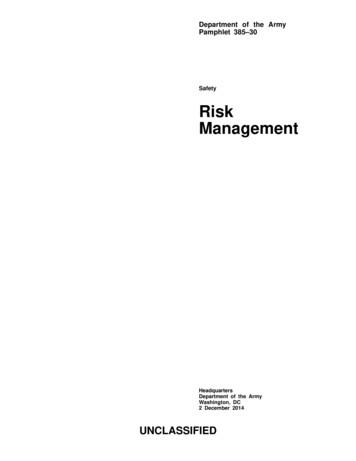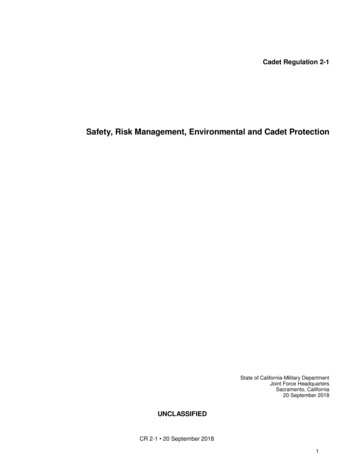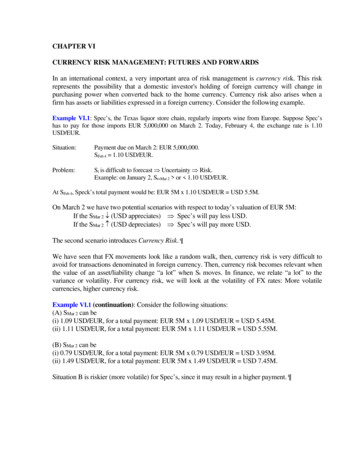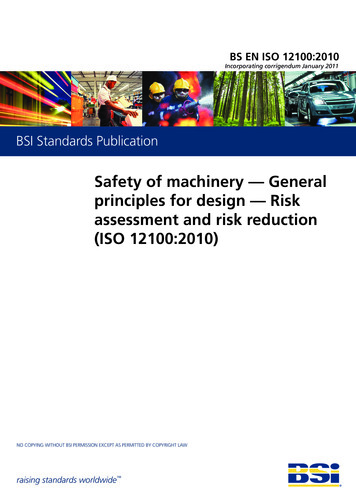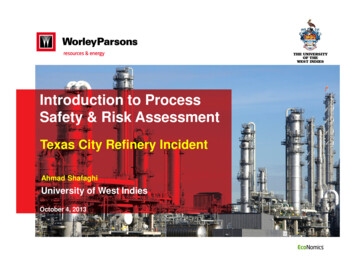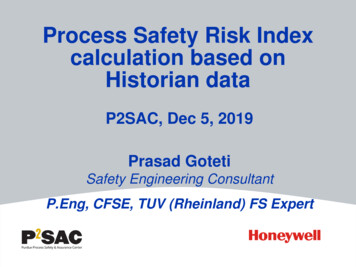
Transcription
CHAPTER 4 - SAFETY RISK MANAGEMENT PROGRAMAINTRODUCTION . 1B.DEFINITIONS . 2C.ROLES AND RESPONSIBILITIES . 2D.REPORTING AND RECORDKEEPING. . 4Attachment 1 - Implementing an Effective Risk Management Program . 5Requirements of a Risk Management Program . 6Step 1 - Identify Hazards . 8Step 2 - Assess Hazards To Determine Risk . 13Step 3 - Develop Controls And Make Risk Decisions. 16Step 4 - Implement Controls . 17Step 5 - Supervise And Evaluate . 17Attachment 2 – Example of a Job Hazard Analysis . 19Attachment 3 - Blank Template - Job Hazard Analysis Blank Template. .20Attachment 4 - Job Hazard Analysis - Welding Example .21Attachment 5 - Operational Risk Management Worksheet - Exhibit Example .24Attachment 6 – Job Observation Form .254-i6.2008
CHAPTER 4 - SAFETY RISK MANAGEMENT PROGRAMAINTRODUCTION1. SI policy (SD 419) is to “ensure that all alleged hazardous conditions areinvestigated, that identified safety and health risks are properly assessed andcontrolled .” Operating environments of the SI comprise a wide variety ofhealth and safety risks that can never be totally eliminated. However, throughthe application of effective risk management principles and resources,associated risks can be reduced to acceptable levels.2. This Chapter describes the Risk Management decision-making process thatshall serve as the SI foundation of a strong and effective Safety, Health andEnvironmental Management Program to accomplish these policy goals.3. This Chapter (together with Chapter 5, “Safety Assessments, Log ofDeficiencies and Corrective Action Plan” of this Manual), contains tools andtechniques developed to enable Directors to accomplish all of the aspects ofthis policy. Attachments to this Chapter provide spreadsheets, hazardanalyses and checklists that will aid Directors, supervisors, SafetyCoordinators and safety committees in performing the duties necessary tocomply with this policy.4. The goal of risk management is to accomplish a balance betweenperformance at the height of one’s potential and still maintain a safe workingenvironment effectively controlling known hazards. Compliance with existingcodes and federal, state and local regulations is often viewed as being quiteexpensive to implement. However, the cost of not complying is also great.The Smithsonian’s 2006 costs owed the Office of Workers CompensationProgram of present and past injuries exceeded 3 million. Compliance withstandards, ensuring availability of sufficient resources for a strong andeffective safety program will save millions of dollars as well as keep ourworkforce and environment healthy and safe. This systematic, decisionmaking process is a proven highly effective method for reducing mishaps thathas been used extensively by organizations such as NASA and theDepartment of Defense and now for reducing injuries to the Smithsonian’semployees and visitors.4-16.2008
B.DEFINITIONS1. Deficiency is an uncontrolled hazard that poses risk of injury, property orenvironmental damage and demonstrates non-compliance with SI SafetyPolicy and/or consensus standards.2. A hazard is a condition with the potential to cause injury, illness, or death ofpersonnel; damage to or loss of equipment, property or collections; orcurtailment of operations.3. Risk is the probability that the hazard will actually cause injury or damage.Many hazards are Inherent to the workplace or process or piece of equipmentused to accomplish our mission, but risk can be reduced by deciding on waysto change or control the hazard (controlling the equipment, using safermaterials, doing the process in a safer manner) and still accomplish thefacility’s mission.4. Risk Management (RM) is the process that guides management decisions toa safer workplace.C.ROLES AND RESPONSIBILITIES1. Directors shall ensure implementation of a safety risk management programthat follows the Guiding Principles and the SI Risk Management Five-StepProcess that are fully addressed in Attachment 1 and Section C.2 below.2. Safety Coordinators and Supervisors shall employ the SI Five-Step RiskManagement Process listed below and further defined in Attachment 1of thisChapter and Chapter 5, “Safety Assessments, Log of Deficiencies andCorrective Action Plan”, of this Manual.a. Step 1- Identify hazards using the following tools and techniquesdiscussed in this Chapter and Chapter 5, and the requirements of thisManual’s Operational Chapters.(1) Employee reports of workplace hazards;(2) Lessons learned from incidents and near misses; and(3) Self-Assessments to include Management Evaluation and TechnicalReviews (METRs), Safety Coordinator Self-Assessments, SafetyCommittee Inspections and IH assessments of hazardous exposures.b. Step 2- Assess risks to life, property and the environment from thosehazards using the Risk Assessment Code, tools and techniques explainedin this Chapter. Consult with the Office of Safety, Health andEnvironmental Management (OSHEM) for risk reduction techniques forRAC 1 and 2 risk assessments.4-26.2008
c. Step 3- Develop controls and make decisions on what risks areacceptable(1) Develop Job Hazard Analyses (JHA) and Workplace (WHA) (refer toexamples in Attachments 1, 2, 3 and 4 of this Chapter), to eliminate orminimize the risks to an acceptable level to meet the requirements ofthis Manual. Hazards that are judged to be immediately dangerousto life and health must be controlled immediately (e.g., process orequipment shut-down).(2) Frequently interact with and observe the employee to ensure theemployee knows and understands the requirements of the job andworkplace hazard analysis and performs safely. Refer to Attachment 6,Job Observation Form.(3) Apply controls listed in the applicable Operational Chapters of thisManual.(4) Provide Safety Training, per the requirements of Chapter 6, “Training”,of this Manual, to raise employee awareness of workplace hazards themeans to guard against being injured by those hazards.(5) Develop Risk Management Worksheets (refer to example inAttachment 5 of this Chapter) for specific operations that involvemultiple hazards; e.g. installing large objects in an exhibit, movingcollections for storage or because of renovation, etc.d. Step 4- Implement controls and track corrective actions throughcompletion.(1)Maintain a current and fully auditable Log of Deficiencies andCorrective Action Plan, per tools and techniques presented inChapter 5, “Safety Assessments, Log of Deficiencies and CorrectiveAction Plan”, of this Manual.(2)Assign personnel to track deficiency abatement.(3)Review JHAs and/or WHAs regularly and change wheneverpersonnel/processes change, or new hazards are introduced into theworkplace.(4)Fellow employees should periodically use the Job Observation Form,Attachment 6 to ensure safe behaviore. Step 5- Periodically evaluate the effectiveness of this 5-step riskmanagement process. Drop controls that clearly do not work and continueto develop controls that do work. When there are changes in theenvironment, reassess the heightened risk that change usually causes.Continue to evaluate the deficiency abatement process.4-36.2008
3. Employees shall provide input in their JHA and will adhere to the safe workpractices identified for each task and periodically review the JHA to eitherimprove it or change it to accommodate changes in procedures orenvironment.4. Office of Safety, Health and Environmental Management (OSHEM) shall:a. Provide technical assistance and a “Train-the-Trainer” course, uponrequest, to Directors and Safety Coordinators in all aspects of the RiskManagement process.b. Conduct and manage all aspects of employee health exposureassessments and medical surveillance to meet regulatory standards forquality assurance, quality control, and legal liability.c. Evaluate the facility or organization’s Safety Risk Management Programannually for compliance with this Chapter.D.REPORTING AND RECORDKEEPING. Documentation for the RiskManagement Program includes:1. Job/Workplace Hazard Analyses periodically reviewed and changedwhenever personnel/processes change, or new hazards are introduced intothe workplace.2. Safety Program Self Assessments and the Log of Deficiencies/CorrectiveAction Plan as described in further detail in Chapter 5, “Safety Assessments,Log of Deficiencies and Corrective Action Plan”, of this Manual.4-46.2008
Attachment 1Implementing an Effective Risk Management ProgramThe Guiding Principles of Risk Management (RM)A. Integrate RM into all phases of missions and operations. Effective RM requiresthat the process be integrated into all phases of mission or operational planning,preparation, execution, and recovery on a continuing basis. It is much more costeffective to plan up front during building construction and renovation to imbed safety,fire and environmental protection systems than to retro-fit after the fact.B. Make risk decisions at the appropriate level. As a decision-making tool, RM isonly effective when the information is concentrated on the appropriate supervisorylevel for decision. The higher the risk, the higher the management level of whoshould make the decision to accept a risk or not. Often this will require the decisionto apply resources, whether manpower, dollars or both, to mitigate risks to anacceptable level so the management decision-making level must be where thepurse strings are controlled.C. Accept no unnecessary risk. Accept no level of risk unless the potential gain orbenefit outweighs the potential loss. RM is a decision-making tool to assist thesupervisor or individual in identifying, assessing, and controlling risks in order tomake informed decisions that balance risk costs (potential losses) against missionbenefits (potential gains). An unnecessary risk is one that if not taken, you can stillaccomplish the mission. For example, an employee forgets or refuses to use eyeprotection during grinding operations. The risk is painful damage to eyes, maybeeven loss of sight, yet the grinding can be successfully accomplished without risk ofeye injury, simply by using eye protection.D. Apply the process cyclically and continuously. RM is a continuous processapplied across the full spectrum of museum and research operations, individual andcollective day-to-day activities and events, and facility operations. It is a cyclicprocess that is used to continuously identify and assess hazards, develop andimplement controls, and evaluate outcomes particularly when changes occur inoperations or environment. To a certain extent RM is intuitive, but it has beenproven most effective when applied in the planning stages of an operation 30, 60, 90even 120 days out, if possible. Refer to Attachment 5 to see an example offormalized risk management. The process is continuous, and therefore synergistic.Evaluation of the process helps continuously improve the process, dropping controlsthat don’t work and incorporating new and better controls for future similaroperations. In essence, this process is demonstrated and accomplished whenSafety Coordinators and OSHEM review plans for renovation or new construction inorder to incorporate OSHA, EPA and NFPA mandated controls and requirements.Fully compliant facilities are the product of early planning and involvement of fire,health, environmental and safety experts throughout the planning stages of the newor renovated facilities.4-56.2008
Attachment 1Requirements of a Risk Management ProgramApply the 5 step risk management process to all SI organization safety programs. Thefollowing provides a brief outline of the 5-step process requirements.Step 1 – Identify hazards.Step 2 – Assess hazards to determine risk.Step 3 – Develop controls and make risk decisions.Step 4 – Implement controls.Step 5 – Supervise and evaluate.Figure 4-1 illustrates how these five steps are cyclical, forming a continual improvementprocess with the first two steps being part of the assessment phase and the last threesteps belonging to management to make decisions, delegate responsibilities andcontinually supervise and evaluate to insure improvement.Figure 4-14-66.2008
Attachment 1Table 4-1 Graphic display of the RM 5-step Process and identifies specific toolsand techniques for accomplishing the program requirements.STEPS IN RM PROCESSStep 1 – Identify hazards.Step 2 – Assess hazards to determinerisk.Step 3 – Develop controls and make riskdecisions.Step 4 – Implement controls and trackcorrective actions through completionStep 5 – Supervise and evaluate thesuccess of the control and the process.TOOLS AND TECHNIQUES discussed in thisSafety Manual Safety committee inspections, Employee identification of workplace andenvironmental hazards Hazards identified while investigating mishaps Supervisors identifying hazards for workplace orjob hazard analyses Safety Coordinator inspections Using the Risk Management Risk AssessmentMatrix, assign a risk assessment code (RAC) toidentified hazards.An initial RAC is assigned to uncontrolledhazards and a residual RAC is assigned tocontrolled hazards. Safety Coordinator safety program evaluation Operational Chapter requirements Safety Training Risk Management Worksheet (Att 5) Job Hazard Analysis (JHA) and/or WorkplaceHazard Analysis (WHA) Log of Deficiencies and Corrective Action Plan Assign personnel to track deficiency abatement Review JHA/WHA weekly or whenever changesoccur Drop controls that clearly do not work Add other controls that do work Add hazards missed during first ID process,particularly when changes in environment,equipment or personnel occur. Evaluate and track abatement of deficienciesTable 4-14-76.2008
Attachment 1STEP 1 - IDENTIFY HAZARDSEach job task or work area within a facility shall be assessed by the supervisor (withassistance from the Safety Coordinator) to identify sources (e.g., locations, equipment,processes, etc.) of safety hazards. Individual hazards are identified by answering thequestions: “What could go wrong, what could cause someone to be hurt or causedamage to property or environment?” This determination may be made using: Brainstorming with staff, seeking staff input on unsafe aspects of their operations,considering “what if” scenarios. Self assessments/inspections. Employee complaints of unsafe working conditions. Identifying past injuries or locations where injuries occur including review ofOSHA 300 Log information Injuries or incidents other similar organizations have experienced. Relying on professionals experienced in identifying hazards for specific jobs orenvironments. Results of employee exposure monitoring (industrial hygiene surveys). Identifying locations or processes that could cause an environmental release orenvironmental pollution.What is a hazard? A hazard is a condition with the potential to cause injury, illness,or death of personnel, damage to or loss of equipment, property or collections,damage to the environment, or curtailment of operations. A hazard may also be asituation or event that could cause a museum or research center to close or stopvital operations. Hazards exist in all environments—laboratories, collection storage,workshops, warehouses, greenhouses, landscaping areas, public display areas.What are the sources of hazards? Hazards may arise from any number of areas.Hazards can be associated with accident potential, weather or environmentalconditions, health, sanitation, behavior, material or equipment conditions or terroristactivity. RM does not differentiate among the sources of the hazard. The loss ofpersonnel, equipment, or collections or damage to the environment due to anyhazard has the same disruptive impact on the Smithsonian mission no matter whatthe source. The bottom-line is the effect of the hazard, not its source.4-86.2008
Attachment 1STEP 1 (cont.) What factors should you consider in identifying hazards? Disrupters (Change, weather, legal issues) Activity Time Employees or Visitors Environmental Health FactorsDisrupters - A new process or piece of equipment introduced into the workplace,weather conditions such as the flood we experienced in July 2006, equipment failure, orlegal issues such as a visitor who sues because an unsafe environment caused injury.Activity - some activities involve higher risk and are inherently more dangerous thanothers. Some things that make activities more dangerous would include job complexity,tools or equipment requiring extra skill or training to use, or lack of clear proceduralguidance and training to perform the activity with no misunderstanding.Time - Was there sufficient time to plan or perform an operation? This could also referto the length of time personnel are exposed to a hazard; the greater the length of theexposure the greater the probability of injury.Employees or Visitors - What is the condition of the employees or visitors? Are theyhealthy? We may have no way of knowing the health status of a visitor, but we cancertainly anticipate and prepare for the unexpected, again, asking what could go wrong.Are employees new and untrained or experienced and trained? It follows that anuntrained or less experienced employee is more likely to be injured. How manypersonnel are exposed to a hazard? If a set of stairs does not have railings that meetthe OSHA requirements and the stair leads to the roof where only one person uses thestair maybe once or twice a month, there will likely be fewer injuries than if the stairs arein a public exhibit space used by employees and hundreds of visitors a day. Are theresufficient trained personnel to safely perform an operation? Lifting heavy objects is lesslikely to cause injury if the weight is shared with 2 or more employees.Environmental Health Conditions - This category includes a variety of health-relatedfactors to include ergonomics, hearing conservation, radiation and chemical hazards,etc. Generally, OSHEM approaches these subjects as a team or task force of severaldisciplines such as Industrial Hygiene for measuring noise, air flow, exposure tohazardous substances, etc., a health specialist who can assess health effects ofspecific hazards to employees, and safety specialists who insure OSHA standards areunderstood and met. All of these categories are covered in greater detail in theoperational Chapters of this Manual.4-96.2008
Attachment 1Example #1: Hazard- Confined Spaces. Hazard is necessary and cannot beeliminated.WHO is exposed: Supervisors, personnel trained on Confined Space.WHAT is the control: Ensure confined spaces are properly labeled, access is limited andpersonnel who enter the spaces are trained to know the hazards and take the required andproper precautions based on the hazards involved.WHERE: Any confined space.WHEN: Before entering the confined space.HOW: Trained, qualified personnel identify and inventory confined spaces and all hazardsassociated with the confined space, label appropriately, and follow all safety requirements of theconfined space program.Example # 2: Heavy LiftingWHO is exposed: Supervisors, leaders, employees.WHAT is the control: Back Injury Prevention. General safety training on back injury prevention;insure proper material handling equipment (for
Manual), contains tools and techniques developed to enable Directors to accomplish all of the aspects of this policy. Attachments to this Chapter provide spreadsheets, hazard analyses and checklists that will aid Directors, supervisors, Safety Coordinators and safety committees in perfo

